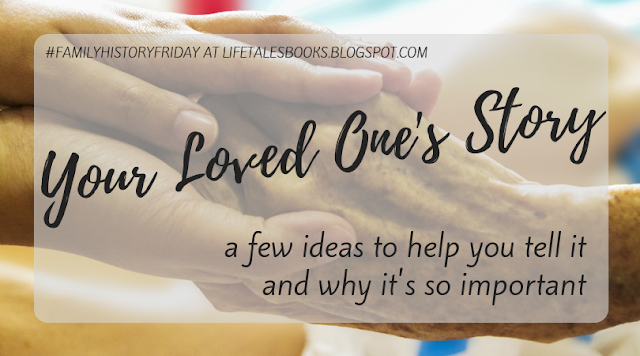"The
things you do for yourself are gone when you are gone, but the things you do
for others remain as your legacy.” -Kalu Kalu
This
is exactly {why every human heart needs his or her family history}!
Stories give us a foundation, something to stand on. Our experiences, our
stories, shape us. There’s always something to learn or appreciate or
remember from everything we go through–even difficulties.
From our own
stories and experiences to the life lessons learned from family history, we are responsible for making sure our legacy is
shared. Family stories, including our stories as a
smaller part of family stories, teach our children (and ourselves) that we can
do hard things, that good times should be remembered over and over again, and
that family ties can be a tremendous source of strength.
What
is Legacy?
Everything
we do and say is part of our legacy. What will you do today that will be
remembered? In a culture that is so addicted to wasting time, this is an
important thing to consider. How much of what you do will be valued by
friends and family 10 or 50 years from now?
"Please
think about your legacy because you are writing it every day.” -Gary
Vaynerchuck
Your
example, talents, gifts, and values are among the things people remember about
you. They remember your sense of humor, your mind, and the care you show
them. Yes, this may be what they remember about you when you’re gone, but
this is also what they will remember about you on Monday when your name comes
up at lunch.
Your legacy is basically what you give to the world at this
moment, tomorrow, and forever.
"Legacy
is not what’s left tomorrow when you’re gone. It’s what you give, create,
impact, and contribute today while you’re here that then happens to live
on.” -Rasheed Ogunlaru
Your
Legacy
Now for all you SAHMs who are reading this
between the fourth and fifth loads of laundry, know that your legacy is like everyone else’s: it’s {drops of awesome} that accumulate over time. (By the way, if you don’t know what Drops of
Awesome are, you should definitely visit that link!) You may not feel
like your legacy will ever be like {Susan B. Anthony}'s or Eleanor Roosevelt’s, but it
really will.
You are creating people (think of that!), families,
traditions, and life lessons. Plus you keep those little people alive
with the food, shelter, and clothing you work so hard on every day. Your legacy will be a lot of things, but it is in large part a
legacy of the purest kind of love, and it doesn’t get any better than
that. Ever.
Your
story is important to every person who loves you. Taking time to record
it is an invaluable gift to them! If you missed this month’s post about
writing and preserving your own story, {you can find it here}.
Your
Family’s Legacy
Your family’s legacy is your
family’s stories. It’s
how your ancestors came to this country, and it’s what they did (and probably overcame)
to get here. It’s how your parents met, how you decided to pursue a trade
vs. a college degree, your family’s faith, and what’s important to you.
Your family’s legacy includes funny stories, good memories of time together,
stories of grit and perseverance, and cherished family traditions. It’s
your family history.
You
can contribute to your family’s legacy by writing down what you know.
{Our story} and {your story} are good places to start.
“My grandpa always said…” and “I remember we would always…” ARE your family
history. They’re your family’s legacy.
"When
our hearts turn to our ancestors, something changes inside us. We feel
part of something greater than ourselves. Our inborn yearnings for family
connections are fulfilled when we are linked to our ancestors.” -Russell
M. Nelson
Build
Your Legacy in Three Steps
- Look
at where you are now, what you’ve learned, and what you can share. (I
love that she also mentions changing direction if you want to.)
- Focus
on the message you want to convey, then work to develop it. (“Your legacy
is created by intentionally showing up.”)
- Think
long term to the future while still being present now. (Look at where you
want to be over time.)
"You
began building your legacy the moment you came into this world. Now it’s time
to start or continue being intentional about it. By starting with what
you’ve already built, defining your message, and thinking long term, you can
continue to become the person who has an impact both in this lifetime and
beyond.” -Brooke Davis
Brooke’s insightful advice can
apply to both personal legacy and family legacy. Look at where you are
and where you want to be, then make decisions and changes and efforts to get
you there.
Remember
that everyone’s legacy happens drop by drop.
Make
a Record
Oral
histories and oral stories are great. Hopefully we’ve all sat at the knee
of a great, engaging storyteller. But for most of us, sitting down and
reminiscing or telling family stories isn’t a very common occurrence. If
you’re anything like me, stories just sitting in my head somewhere can be
forgotten. Even if I remember the story, I
can forget to tell it.
I wrote a couple of months ago
in {Building Bridges between Generations Using Photos and Memories} that
it took a somewhat random moment for me to remember a life-changing experience
I had that I had never told my children! It’s a great story, and one I
cherish, but it had never come up in conversation, so I’d never told them about
it. It just never occurred to me.
Taking the time to sit down and
review your life (with its attending lessons and experience) is not only
therapeutic, but
it helps you remember things you might not otherwise. A journal is a
great resource if you have it, but if not, you can find some thought-provoking
questions here.
This tutorial walks you through the steps of creating your own legacy storybook for your family:
Recording your stories is one
of the best ways to spend your time because it’s one of the best ways to share
your legacy with those who love you.
 |
Save and share this article by Pinning this image to Pinterest or by
using the social media share buttons at the left for Facebook, Twitter, LinkedIn, etc. |
This
post was originally published at www.livegrowgive.org on June 29, 2018, by Jennifer
Wise. Find more #familyhistoryfriday blog posts about stories, photos, memories, connections, and family by clicking the hashtag below next to Labels.
Hooray! This blog post was a featured favorite here:
Follow Photo & Story Treasures on social media here:






































